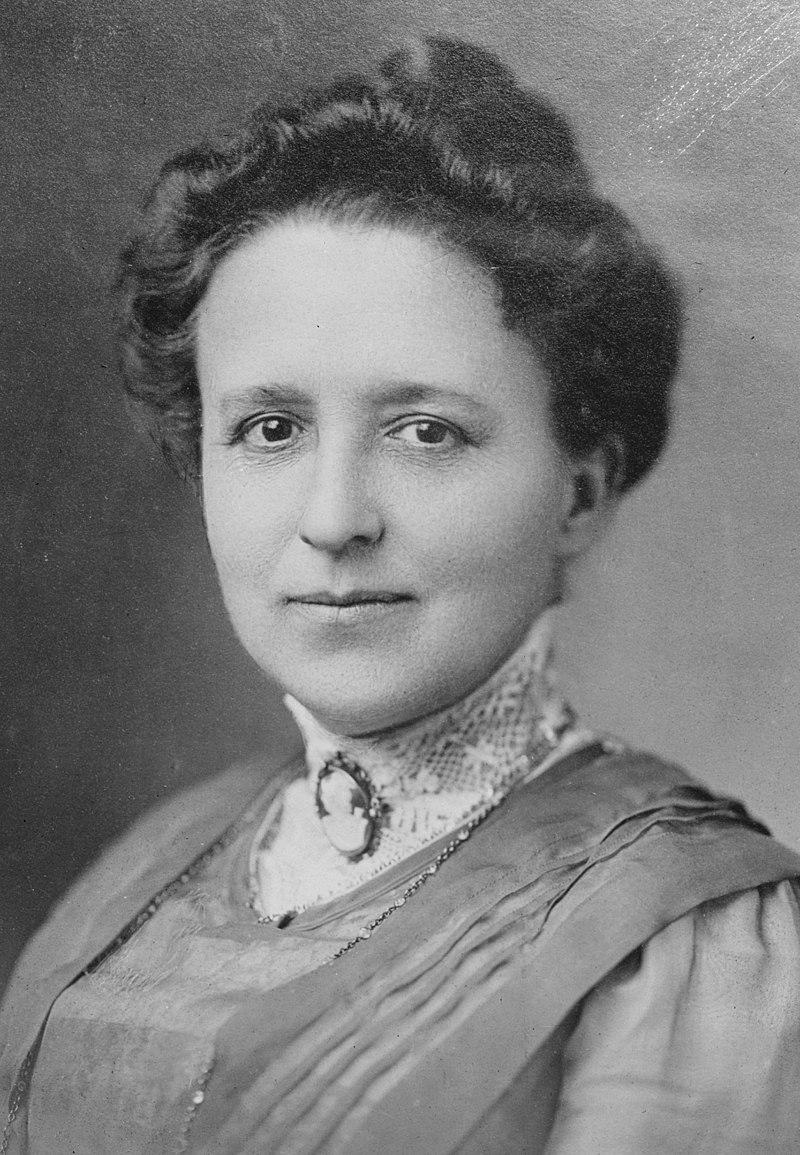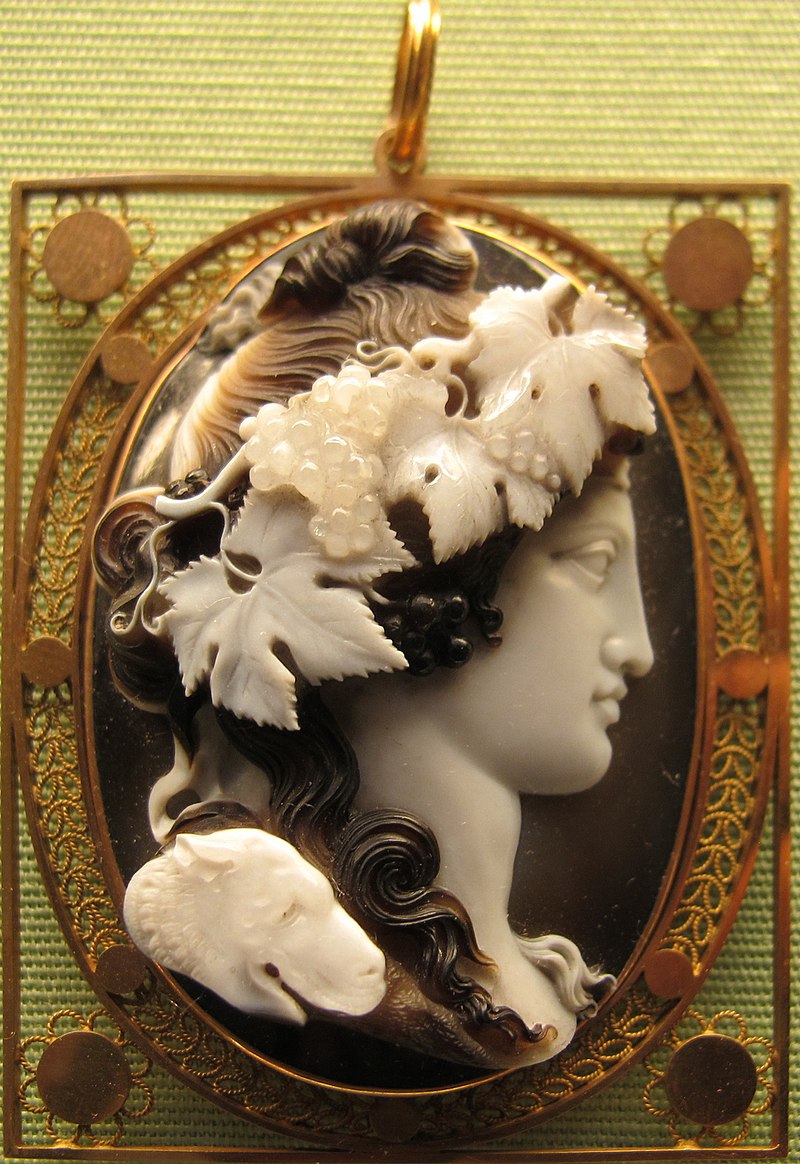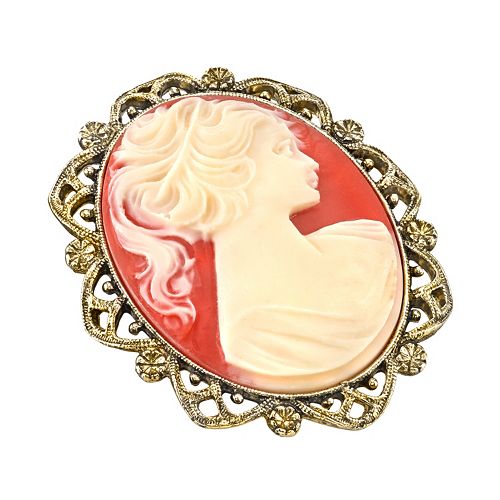Cameos--a carving with a raised relief of contrasting color, that often depicts a person's profile or scene from mythology--are commonly made of shell, coral, lava, glass, or stone, and set in metal to be worn as jewelry. Queen Victoria of England adored them, and her affection for them set off a trend for women to wear them, followed to this day.
 |
| Queen Victoria wears cameos as pins and a bracelet in this portrait by Heinrich von Angeli, 1875. Public Domain. |
However, cameos have been around far longer than Queen Victoria, and they used to be worn by men as well as women. They were also worn differently than they are usually worn now: the notion of a woman pinning a cameo to the high, lacy neck of her dress, originated in the Edwardian period, about a hundred years ago.
 |
| Woman with cameo pinned to her throat, circa 1912. Photographer and subject unknown. Public Domain. |
Cameos are believed to have originated sometime around the 3rd Century BC. The Greeks and Romans created numerous cameos, featuring images of gods and goddesses or mythological scenes. They were worn as rings, earrings, or admired as
objets d'art.
Sometimes hidden messages were attached to them. For example, a Hellenistic young woman might wear a cameo depicting Eros to indicate she was romantically interested.
 |
| Athena wearing the ægis. Sardonyx cameo, late 1st century BC. The mount was added later: enameled gold by Josias Belle, late 17th century. Public Domain. |
Other cameos were created to honor political figures. The Blacas Cameo, showing the profile of Emperor Augustus, is rather large at almost 13 cm high. Carved from sardonyx, it was created sometime around 20 AD. The pose and details are symbolic, invoking the gods and highlighting Augustus' "divine attributes." This cameo is one of the "State Cameos" of Augustus that are believed to have originated in Augustus's inner circle.
Christians created cameos in the Byzantine era, often to be worn as
enkolpions, a devotional medallion or pendant. Common carvings include angels, saints, and scenes from the Bible.
Cameos' popularity waxed and waned through the centuries, but continued to be crafted from semi-precious gemstones like onyx and agate. They found a popular following in the Renaissance. Pope Paul II (1417-1471) was apparently an avid collector of cameos, and one fanciful story claims that he wore so many cameo rings, his hands got too cold, and he caught a chill that resulted in his death! (Other accounts say he died of a heart attack, stroke, or eating too much melon.) Regardless, he owned several, and much of his collection passed to Lorenzo de Medici.
Women began to wear and collect cameos during the Elizabethan Period as a display of wealth and status. Often cameos continued to depict Roman or Hellenistic gods or rulers, to give the appearance of antiquity.
 |
| Cameo Portrait of Roman Emperor Tiberias mounted on a ring, circa 1625-1675, Italy. Public Domain. |
Monarchs and wealthy folks around Europe continued to wear cameos in the coming years. Queen Anne of England gifted one to Pocahontas. Napoleon Bonaparte wore one to his wedding, and so enjoyed them that he even founded a Parisian school to teach the art of cameo carving to craftsmen.
 |
| Cameo circa 1800 by Benedetto Pistrucci, Italian gem-engraver. Public Domain. |
In the nineteenth century, the popularity of shell cameos grew (as opposed to more expensive semi-precious stones), and profiles became a popular subject matter for the masses.
 |
| Cameo bracelet with portraits of the Hunt Brothers, by William Morris Hunt, c. 1840, gold, shell. Public Domain. |
A new method of cameo carving came into being in the late 19th century, too: incrustation. An engraver carves a portrait, makes a cast of it, and from there produces a ceramic cameo which is then encased in glass. Although the process originated in Bohemia, French glassmakers became proficient, and the Bakewell Glass Company in Pittsburgh, Pennsylvania crafted beautiful pieces in this manner, from knobs to tumblers, vases to paperweights. (To see an example, visit
here.)
Today, cameos are mainly worn by women, and cameos can be purchased in any medium from agate to plastic.
What about you? Do you own a cameo?
***
Giveaway: Please comment below by 11:59 pm PDT, June 6, 2019, to enter to win a copy of Cameo Courtships. Include an email address. Void where prohibited.
A Family Heirloom Inspires Romance
In 1851, the “Victoria Cameo” is gifted by Queen Victoria to Letitia Newton, who though considered an old maid, soon has the attention of three gentlemen. Inspired by her own romance and quick marriage, Letitia decides to gift the cameo to other women in her family, hoping romance will follow....
***
Susanne Dietze is a 2019 RWA RITA-nominated author who has published fifteen romances with Timeless Heart. To learn more about her and her stories, please visit her website, www.susannedietze.com.














I don't own a cameo. They are beautiful though. Thanks for the interesting post. For some reason I thought they were also made from ivory.
ReplyDeleteSorry, my email is bcrug(at)twc(dot)com
DeleteThanks, Connie! You know, it's possible that some were made from ivory! I'll have to do some research and find out.
DeleteThanks for coming by and entering the drawing!
I love my cameo. I pre-ordered Cameo Courtship and loved it as well. Let a review by the way. Thanks for sharing such an interesting post.
ReplyDeleteOh, thank you so much for taking the time to read and review Cameo Courtships. What a blessing to the authors! I'm glad you enjoyed it. Have a great day!
DeleteI have a cameo that belonged to my great-grandmother. It is gorgeous, but I've never worn it. Maybe someday!
ReplyDeleteOoh Lisa, it must be stunning! What a special heirloom.
DeleteThank you so much for coming by!
I don't have a cameo but they have always fascinated me. Very interesting.
ReplyDeleteThe process of making a stone cameo is interesting, isn't it? And how people wore and enjoyed them. Quite a long history!
DeleteThank you for coming by. I hope you have a great day.
Oh wow this bit of history is wonderful. Thank you for sharing with us. I love cameos. My mom had one on a necklace that she was going to give me after she passed. Sadly, after she passed my sister and I could not find it. Oh well, I still have lots of memories about it with mom. I would love to read this book. The idea of a family heirloom passing down like this just sounds fascinating.
ReplyDeletequilting dash lady at comcast dot net
Lori, that is so sad! I wonder what happened--that's quite a mystery. You are so right, though, that the memories are precious and wonderful.
DeleteThank you so much for coming by!
I don't own a cameo but I think they are lovely! Looking forward to reading the stories in your new book!
ReplyDeletecolorvibrant at gmail dot com
Hi Heidi! I don't own a cameo, either! LOL...unless you count some bookmarks I just made. I will have to be on the lookout for one to keep as a memento of this book.
DeleteHave a great day!
I do not have a cameo but I think they are lovely.
ReplyDeletemauback55 at gmail dot com
Same with me, Melanie. One of these days, I'll have to look into a vintage cameo.
DeleteHave a great day.
I love cameos and own a few pieces of them. I have a couple of pins and a pair of earrings that belonged to my grandmother. I had bought a small pin when I was a teenager and wore it pinned to a ribbon as a choker when it was popular to wear it that way. Right now, I'm eyeing one pin that's in a little dish on my desk. I love looking at it.
ReplyDeletebluedawn95864 at gmail dot com
Oh how fun, Bonnie! Cameos are fascinating, aren't they? The images in them can vary to great extent. I'm so glad you're a cameo fan!
DeleteThank you so much for coming by!
Interesting bit of history. I don't have a cameo, love what they look like, but I’m not sure I would wear one. I suppose it would depend on who gave it to me :) Thanks for the giveaway - I know I would enjoy the stories!
ReplyDeletebettimace at gmail dot com
Good point, Betti. The giver of the gift makes a huge difference sometimes.
DeleteYou're entered into the drawing. Have a great day!
My grandmother had a cameo that she gave to my mother. I loved it and thought it so pretty. It had a blue background, and I would love to have had it, but my sister and I never found it among her things after her death. So, I don't know what happened to it. Sure wish I still had it. Thanks for the history of them. I never knew all this, just that it was a beautiful piece of jewelry.
ReplyDeleteOh Martha, I'm sorry you never found it. Cameos heirlooms are so precious.
DeleteI loved learning about the history of cameos, as well. I hadn't realized they'd been popular for a few thousand years!
I don't own a cameo. I think cameos have a timeless beauty.
ReplyDeletepsalm103and138atgmaildotcom
They absolutely do have a timeless beauty, don't they? They've been around for thousands of years...that's amazing to me!
DeleteHave a great day, Caryl!
I always liked the look of cameos. I don't own one though. Thanks for giving us the history and for the chance to win your book.
ReplyDeletepmkellogg56{at]gmail[dot]com
You're most welcome, Pam! This book was so much fun to work on.
DeleteHave a wonderful day.
I do not own a cameo, but I have always found them beautiful. Loved reading the history behind the cameos.
ReplyDeleteI don't own one, either! As I did research, I found some vintage ones on etsy that caught my eye. Who knows, maybe someday.
DeleteHave a wonderful day.
Fascinating post, Susie. I thought cameos depicted a person so their loved one could have them with them and show them off. I have a costume jewelry type similar to the final image in your post which I bought as a prop for my Edwardian story. Thanks for sharing the history of the cameo. I'm looking foward to the collection. :)
ReplyDeleteThanks, Anita! I admit I was surprised that cameos were used politically and religiously. I had seen ones depicting women's profiles and scenes from Greek mythology, but had no idea they went back so far in time.
DeleteI hope you enjoy the stories!
Thanks to all who entered! The winner is Bonnie K. Bonnie, I'll be in contact with you!
ReplyDelete